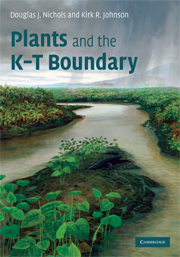Book contents
- Frontmatter
- Contents
- Preface
- PART I BACKGROUND
- 1 Introduction
- 2 Resolution of the K–T boundary
- 3 Using fossil plants to study the K–T boundary
- 4 Brief history of K–T boundary paleobotany and palynology
- 5 Overview of latest Cretaceous and early Paleocene vegetation
- PART II REGIONAL CASE STUDIES
- PART III INTERPRETATIONS
- Appendix
- References
- Index
3 - Using fossil plants to study the K–T boundary
Published online by Cambridge University Press: 22 August 2009
- Frontmatter
- Contents
- Preface
- PART I BACKGROUND
- 1 Introduction
- 2 Resolution of the K–T boundary
- 3 Using fossil plants to study the K–T boundary
- 4 Brief history of K–T boundary paleobotany and palynology
- 5 Overview of latest Cretaceous and early Paleocene vegetation
- PART II REGIONAL CASE STUDIES
- PART III INTERPRETATIONS
- Appendix
- References
- Index
Summary
The study of palynoflora
Palynofloras are essential to studies of the K–T boundary in nonmarine rocks. Numerous aspects of the nature of palynofloras must be considered when using them in such studies. These include: taxonomy (pollen or spore species vs. botanical species), preservation and preparation, sample size, facies effects, reworking or redeposition, stratigraphic resolution, and geographic coverage. These topics are covered in depth in textbooks on palynology (e.g., Traverse 1988b, Jansonius and McGregor 1996, Jones and Rowe 1999), but to be complete in our coverage of the use of palynofloras to study the K–T boundary, each of these topics is briefly discussed in this section.
Most genera of angiosperms (flowering plants) produce pollen with distinguishing morphologic features unique to those genera (number of apertures, exine structure and sculpture, size, etc.), which are the basis of palynological taxonomy. Most species within individual genera share the same characteristic features. Hence, whereas individual living and fossil genera can be differentiated, in most cases individual species cannot. Therefore, as a general rule, fossil pollen species can be thought of as representing botanical genera in the fossil record, and fossil pollen genera can be thought of as representing botanical families. This generality complicates the comparison between palynofloral and megafloral systematics. Comprehensive descriptions of the pollen morphology of living genera and species are in Edrtman (1965, 1966), and discussions and examples of the relationships of fossil pollen taxa to botanical taxa are in Muller (1970) and Traverse (1988b).
- Type
- Chapter
- Information
- Plants and the K-T Boundary , pp. 27 - 33Publisher: Cambridge University PressPrint publication year: 2008



